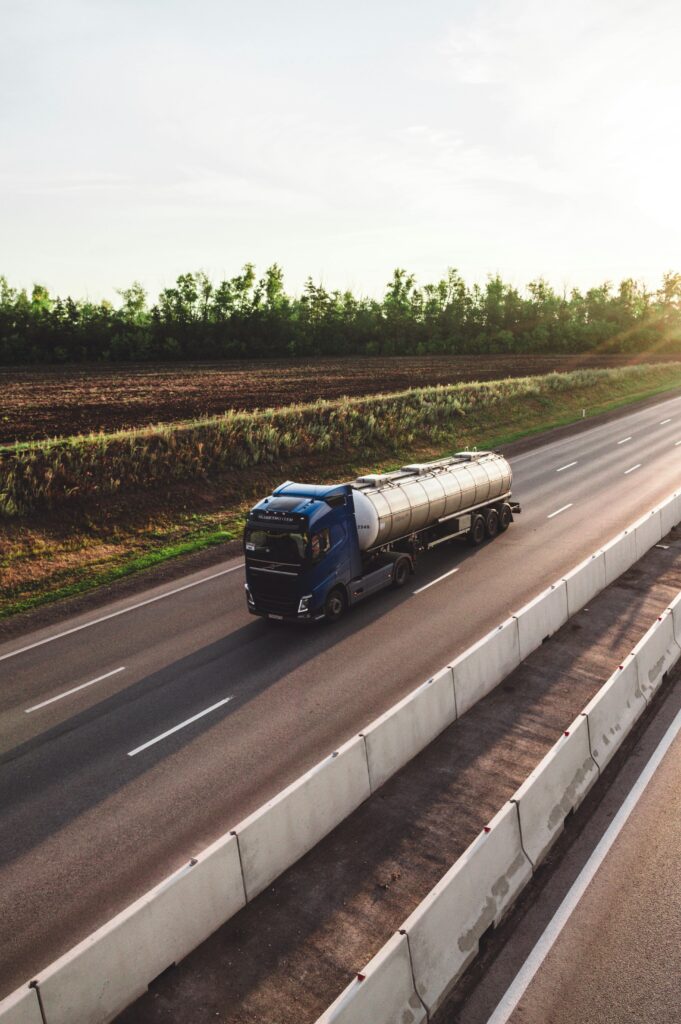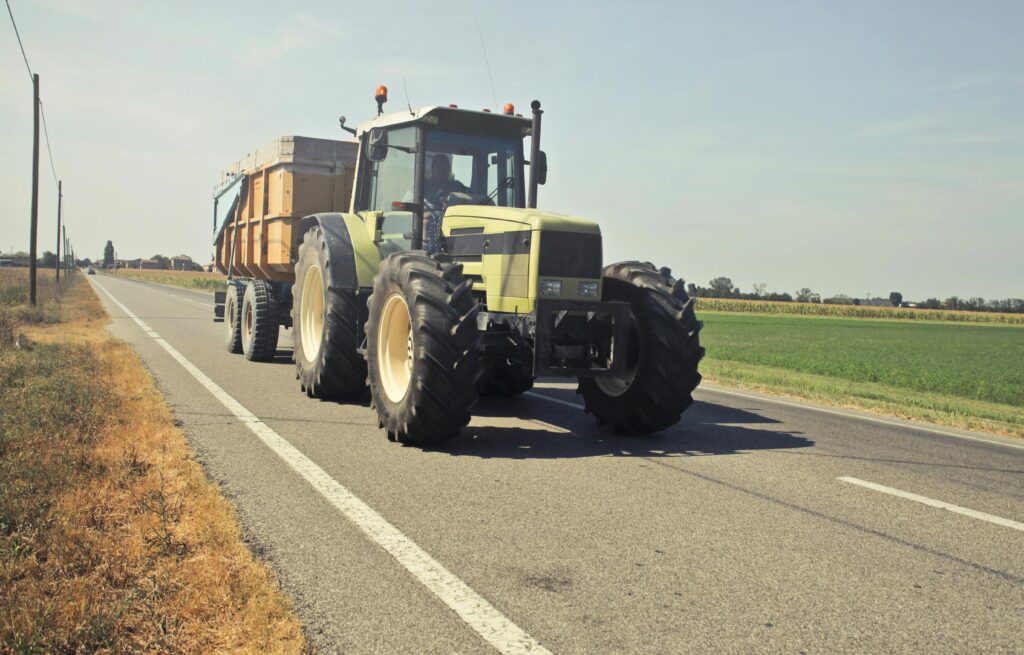A fully loaded tractor-trailer gracefully cruises down the highway at 55 miles per hour, its massive form cutting through the air with efficiency and purpose. With every turn of its wheels, it carries a payload of goods destined for distant destinations, embodying the tireless spirit of commerce and transportation.
Introduction
Tractor trailers, also known as semi-trucks or 18-wheelers, are massive vehicles that play a crucial role in the transportation of goods across the country. When fully loaded, these behemoths can weigh up to 80,000 pounds (36,287 kg), and their sheer size and momentum make them a force to be reckoned with on the roads. In this article, we’ll delve into the physics and dynamics of a fully loaded tractor trailer traveling at 55 miles per hour (88.5 km/h), exploring the various factors that come into play and the implications for safety and efficiency.
The Principles of Motion
Newton’s Laws of Motion
To understand the dynamics of a tractor trailer in motion, we must first grasp the fundamental principles that govern its movement. Newton’s laws of motion provide the foundation for analyzing the forces acting upon the vehicle and how they affect its behavior.
- Newton’s First Law (Law of Inertia): An object at rest will remain at rest, and an object in motion will remain in motion at a constant velocity unless acted upon by an external force.
- Newton’s Second Law (Law of Acceleration): The acceleration of an object is directly proportional to the net force acting upon it and inversely proportional to its mass.
- Newton’s Third Law (Law of Reciprocal Actions): For every action, there is an equal and opposite reaction.
These laws help explain the challenges faced by a fully loaded tractor trailer as it navigates the roads, including the need for longer braking distances, the impact of external forces like wind resistance, and the potential for jackknifing or rollovers during sudden maneuvers.
Kinetic Energy and Momentum
Kinetic energy and momentum are two important concepts that come into play when analyzing the motion of a tractor trailer. Kinetic energy is the energy possessed by an object due to its motion, while momentum is a measure of the object’s mass and velocity.
The kinetic energy (KE) of an object is given by the formula:
Copy code KE = 1/2 * m * v^2
Where:
- m is the mass of the object
- v is the velocity of the object
The momentum (p) of an object is given by the formula:
With a fully loaded tractor trailer weighing up to 80,000 pounds (36,287 kg) and traveling at 55 miles per hour (88.5 km/h or 24.6 m/s), both its kinetic energy and momentum are immense. This has significant implications for the vehicle's stopping distance, the force of impact in a collision, and the potential for damage and injury.
The Dynamics of a Tractor Trailer
Weight Distribution and Center of Gravity
One of the critical factors affecting the dynamics of a tractor trailer is its weight distribution and center of gravity. A fully loaded trailer can carry tens of thousands of pounds of cargo, and how that weight is distributed can significantly impact the vehicle’s stability and handling.
The center of gravity (CG) is the point at which the vehicle’s weight can be considered to be concentrated. For a tractor trailer, the CG is typically located somewhere between the fifth wheel (the coupling point between the tractor and trailer) and the rear axles of the trailer.
Proper weight distribution is crucial for maintaining control and preventing rollovers or jackknifing incidents. Ideally, the weight should be evenly distributed across the length of the trailer, with the CG as low as possible to improve stability.
Aerodynamics and Wind Resistance
Another important consideration when analyzing the dynamics of a tractor trailer is aerodynamics and wind resistance. The large, boxy shape of a tractor trailer creates significant aerodynamic drag, which increases fuel consumption and affects the vehicle’s handling, particularly at higher speeds.
Wind resistance is a force that acts in opposition to the vehicle’s motion, and it increases exponentially with speed. At 55 miles per hour, a fully loaded tractor trailer experiences substantial wind resistance, which can make it challenging to maintain control, especially in windy or gusty conditions.
To mitigate these effects, modern tractor trailers often incorporate aerodynamic design elements, such as cab extenders, side skirts, and trailer tails, which can reduce drag and improve fuel efficiency.

Braking and Stopping Distances
One of the most critical aspects of tractor trailer dynamics is braking and stopping distances. Due to their immense mass and momentum, fully loaded tractor trailers require significantly longer stopping distances compared to passenger vehicles.
The stopping distance of a vehicle is determined by two components: reaction distance and braking distance. Reaction distance is the distance traveled from the moment the driver recognizes the need to brake until they actually apply the brakes. Braking distance is the distance traveled from the point of brake application until the vehicle comes to a complete stop.
For a fully loaded tractor trailer traveling at 55 miles per hour, the total stopping distance can be well over 300 feet (91 meters), assuming ideal road conditions and a skilled driver. This distance can increase substantially in adverse weather conditions, such as rain, snow, or ice, or if the vehicle’s braking system is not well-maintained.
To account for these longer stopping distances, tractor trailer drivers must maintain a greater following distance from other vehicles and anticipate potential hazards well in advance.
Safety Considerations
Driver Training and Qualifications
Given the unique challenges and risks associated with operating a fully loaded tractor trailer, driver training and qualifications are of utmost importance. In most jurisdictions, commercial driver’s license (CDL) holders must undergo specialized training and meet specific requirements to operate tractor trailers.
This training covers topics such as vehicle inspection, load securement, defensive driving techniques, and emergency procedures. Additionally, drivers must comply with regulations regarding hours of service, which limit the number of consecutive hours they can operate a tractor trailer to prevent fatigue-related incidents.
Vehicle Maintenance and Inspections
Proper vehicle maintenance and regular inspections are crucial for ensuring the safe operation of a tractor trailer. Failure to maintain critical components, such as brakes, tires, and suspension systems, can have catastrophic consequences.
Pre-trip and post-trip inspections are mandatory for commercial drivers, allowing them to identify and address any potential issues before hitting the road. Regular maintenance schedules, including brake adjustments, tire rotations, and fluid checks, help prevent mechanical failures and keep the vehicle in optimal condition.
Load Securement and Distribution
The proper securement and distribution of cargo within the trailer are essential for maintaining the vehicle’s stability and preventing load shifts or spills, which can lead to hazardous situations on the road.
Various techniques and equipment, such as straps, chains, and load bars, are used to secure cargo and prevent it from shifting during transit. Additionally, proper weight distribution within the trailer is crucial to maintain the vehicle’s center of gravity and prevent rollovers or jackknifing incidents.
Regulatory Frameworks and Compliance
Federal Motor Carrier Safety Regulations (FMCSRs)
In the United States, the Federal Motor Carrier Safety Administration (FMCSA) is responsible for establishing and enforcing regulations governing the operation of commercial motor vehicles, including tractor trailers.
The Federal Motor Carrier Safety Regulations (FMCSRs) cover a wide range of areas, including driver qualifications, hours of service, vehicle maintenance and inspection, cargo securement, and hazardous materials transportation.
Compliance with these regulations is mandatory for all commercial motor carriers and drivers, and violations can result in significant fines and penalties, as well as potential legal liabilities in the event of an accident or incident.
State and Local Regulations
In addition to federal regulations, tractor trailer operators must also comply with state and local laws and regulations governing the operation of commercial vehicles. These regulations may include specific weight and size limits, route restrictions, and additional safety requirements.
Failure to comply with state and local regulations can result in fines, vehicle impoundment, or other penalties, depending on the severity of the violation.
Industry Standards and Best Practices
Beyond regulatory compliance, many trucking companies and industry organizations have established their own standards and best practices for the safe and efficient operation of tractor trailers. These standards often exceed the minimum requirements set forth by federal and state regulations and are designed to promote a culture of safety and professionalism within the industry.
Examples of industry standards and best practices may include more stringent driver training programs, advanced vehicle safety technologies, and comprehensive safety management systems.

Fuel Consumption and Emissions
The operation of tractor trailers, especially when fully loaded and traveling at highway speeds, has a significant impact on fuel consumption and emissions. Factors such as aerodynamics, engine efficiency, and driving techniques all play a role in determining the vehicle’s fuel economy and environmental footprint.
At 55 miles per hour, a fully loaded tractor trailer can consume between 6 and 8 miles per gallon of diesel fuel, depending on various factors such as the vehicle’s age, maintenance, and the terrain. This translates to a fuel consumption rate of approximately 0.125 to 0.167 gallons per mile (0.295 to 0.394 liters per kilometer).
In addition to the economic impact of high fuel costs, the consumption of diesel fuel also contributes to greenhouse gas emissions and air pollution. Diesel engines emit various pollutants, including carbon dioxide (CO2), nitrogen oxides (NOx), particulate matter (PM), and sulfur oxides (Sox), which can have negative impacts on the environment and human health.
To mitigate these effects, several strategies have been employed in the trucking industry, including:
- Aerodynamic Improvements: Incorporating aerodynamic features, such as cab extenders, side skirts, and trailer tails, can reduce drag and improve fuel efficiency.
- Engine and Vehicle Technologies: Modern tractor trailers are equipped with more efficient engines, advanced emission control systems, and technologies like automated manual transmissions and idle reduction systems, which can reduce fuel consumption and emissions.
- Alternative Fuels: Some trucking companies have begun exploring the use of alternative fuels, such as natural gas, biodiesel, or renewable diesel, which can have lower emissions and potentially reduce the environmental impact of tractor trailer operations.
- Driver Training: Educating drivers on efficient driving techniques, such as maintaining consistent speeds, avoiding excessive idling, and implementing progressive shifting practices, can significantly improve fuel economy and reduce emissions.
Tire Selection and Maintenance
The selection and maintenance of tires on a tractor trailer are critical factors that can impact fuel efficiency, emissions, and overall operating costs. Properly inflated and maintained tires not only improve safety but also reduce rolling resistance, which can result in better fuel economy.
Low rolling resistance tires, designed specifically for tractor trailers, can provide significant fuel savings compared to conventional tires. These tires feature advanced compounds and tread designs that minimize energy loss due to rolling resistance, translating into lower fuel consumption and reduced emissions.
Regular tire inspections and maintenance, including proper inflation pressures and timely rotations and replacements, are essential for maximizing the fuel efficiency benefits of low rolling resistance tires and ensuring their longevity.

Route Planning and Optimization
Efficient route planning and optimization can play a significant role in reducing the environmental impact and improving the overall efficiency of tractor trailer operations. By carefully selecting routes that minimize distance, avoid traffic congestion, and take advantage of favorable terrain and weather conditions, trucking companies can reduce fuel consumption and emissions while also improving delivery times and driver productivity.
Advanced routing and scheduling software, coupled with real-time traffic and weather data, can help optimize routes and minimize idle time, further contributing to fuel savings and reduced emissions.
Additionally, strategies such as load consolidation, where multiple shipments are combined into a single load, can reduce the number of tractor trailers on the road, further reducing fuel consumption and emissions while improving overall efficiency.
Emerging Technologies and Future Trends
Advanced Driver Assistance Systems (ADAS)
The integration of Advanced Driver Assistance Systems (ADAS) in tractor trailers is an emerging trend that promises to enhance safety, improve efficiency, and reduce the environmental impact of these massive vehicles.
ADAS technologies, such as adaptive cruise control, lane departure warning systems, blind spot monitoring, and automatic emergency braking, can assist drivers in maintaining control, avoiding collisions, and optimizing vehicle performance.
By helping to prevent accidents and mitigate the consequences of unavoidable collisions, ADAS can contribute to improved safety for both tractor trailer operators and other motorists sharing the roads.
Additionally, some ADAS features, like predictive cruise control and eco-driving assistance, can help optimize fuel consumption and reduce emissions by providing real-time feedback and guidance to drivers on efficient driving techniques.
Connected and Automated Truck Platooning
Truck platooning, a concept where multiple tractor trailers travel in a coordinated formation with reduced following distances, is an emerging technology that leverages connectivity and automation to improve efficiency and safety.
In a platooning system, a lead tractor trailer sets the pace and trajectory, while the following vehicles use advanced sensors and communication systems to maintain a precisely controlled distance and synchronize their movements with the lead vehicle.
This close formation reduces aerodynamic drag, resulting in significant fuel savings and reduced emissions for the platooning vehicles. Additionally, the automated control systems and coordinated braking can improve safety by reducing the potential for collisions and optimizing braking distances.
While truck platooning is still in the early stages of development and deployment, it represents a promising avenue for improving the efficiency and environmental impact of tractor trailer operations.
Electric and Hybrid Tractor Trailers
As concerns about emissions and environmental impact continue to grow, the development of electric and hybrid tractor trailers is gaining momentum. While the adoption of these technologies has been relatively slow in the trucking industry due to challenges such as battery range, weight, and cost, significant advancements are being made.
Electric tractor trailers, powered by large battery packs, offer the potential for zero tailpipe emissions and reduced noise pollution, making them particularly attractive for urban and regional delivery operations.
Hybrid tractor trailers, which combine a conventional diesel engine with an electric motor and battery pack, can provide improved fuel efficiency and reduced emissions compared to traditional diesel-powered vehicles, especially in stop-and-go traffic or urban environments.
As battery technology continues to improve and charging infrastructure expands, the adoption of electric and hybrid tractor trailers is expected to increase, contributing to a more sustainable and environmentally friendly trucking industry.
Autonomous Trucking
One of the most significant emerging technologies in the trucking industry is autonomous or self-driving vehicles. While fully autonomous tractor trailers are still in the research and development stages, various levels of automation are being explored and tested.
Some of the potential benefits of autonomous trucking include:
- Improved Safety: Autonomous systems can help reduce human error, which is a leading cause of accidents involving commercial vehicles. These systems can monitor the vehicle’s surroundings, detect potential hazards, and take appropriate action to avoid collisions.
- Increased Efficiency: Autonomous trucks can optimize routes, maintain consistent speeds, and minimize idling, leading to improved fuel efficiency and reduced emissions.
- Driver Assistance: Even in semi-autonomous modes, advanced driver assistance systems can help alleviate driver fatigue and support safer and more efficient operations.
- Labor Savings: As autonomous technology matures, it could potentially reduce the need for human drivers, resulting in labor cost savings for trucking companies.
However, there are also significant challenges to overcome, such as developing reliable and robust autonomous systems, addressing cybersecurity concerns, and navigating the legal and regulatory frameworks surrounding autonomous vehicles.
Blockchain and Supply Chain Transparency
Blockchain technology, best known for its applications in cryptocurrencies, is also being explored for its potential to revolutionize supply chain management and logistics in the trucking industry.
By creating a decentralized, tamper-proof digital ledger, blockchain can provide enhanced transparency, traceability, and accountability throughout the supply chain. This can help ensure the integrity of cargo, facilitate efficient tracking and documentation, and streamline processes such as customs clearance and regulatory compliance.
Additionally, blockchain-based systems can enable secure and transparent transactions, payments, and smart contracts between various parties in the supply chain, reducing the need for intermediaries and improving overall efficiency.
Internet of Things (IoT) and Telematics
The Internet of Things (IoT) and telematics technologies are transforming the way tractor trailers are monitored, maintained, and operated. By equipping vehicles with a network of sensors and communication devices, real-time data can be collected and analyzed to optimize performance, improve safety, and enhance operational efficiency.
Some applications of IoT and telematics in the trucking industry include:
- Vehicle Monitoring: Sensors can monitor various vehicle systems, such as engine performance, tire pressure, and brake wear, allowing for predictive maintenance and reducing the risk of breakdowns.
- Driver Behavior Monitoring: Telematics systems can track driver behavior, such as speeding, harsh braking, and idling, providing valuable data for driver training and coaching programs.
- Route Optimization: Real-time traffic and weather data, combined with telematics information, can be used to optimize routes and minimize delays, reducing fuel consumption and improving delivery times.
- Cargo Tracking: IoT-enabled cargo tracking systems can provide real-time visibility into the location and condition of goods being transported, enabling more efficient supply chain management.
As IoT and telematics technologies continue to evolve, their integration into tractor trailer operations will become increasingly important for enhancing safety, efficiency, and competitiveness in the trucking industry.
Conclusion
The dynamics and considerations surrounding a fully loaded tractor trailer traveling at 55 miles per hour are complex and multifaceted. From the fundamental principles of motion and the physics involved to the environmental and regulatory frameworks governing their operation, these massive vehicles present unique challenges and responsibilities.
Understanding the immense forces and momentum at play, as well as the critical importance of proper weight distribution, aerodynamics, and braking systems, is essential for ensuring the safe operation of tractor trailers on our nation’s highways.
Moreover, the trucking industry’s impact on fuel consumption, emissions, and the environment cannot be overlooked. As society increasingly prioritizes sustainability and environmental responsibility, the adoption of innovative technologies and strategies to improve fuel efficiency, reduce emissions, and optimize operations will become paramount.
Emerging technologies such as advanced driver assistance systems, autonomous trucking, blockchain, and IoT/telematics offer promising solutions to enhance safety, efficiency, and transparency in the industry. However, their successful implementation will require careful consideration of regulatory frameworks, cybersecurity concerns, and the potential societal impacts.
As we look to the future, it is clear that the operation of fully loaded tractor trailers will continue to evolve, driven by the need for increased safety, efficiency, and environmental sustainability. By embracing technological advancements, fostering industry collaboration, and maintaining a commitment to regulatory compliance and best practices, the trucking industry can navigate these challenges and continue to play a vital role in the transportation of goods and the growth of our economy.
FAQs
Q1: How does the weight of a fully loaded tractor trailer affect its stopping distance?
A fully loaded tractor trailer can weigh up to 80,000 pounds (36,287 kg), and its immense mass and momentum significantly increase its stopping distance compared to smaller vehicles. Due to the vehicle’s weight, the braking force required to stop it is much greater, and the inertia it carries at highway speeds makes it more challenging to decelerate quickly. At 55 miles per hour (88.5 km/h), the total stopping distance for a fully loaded tractor trailer can exceed 300 feet (91 meters) under ideal conditions, and it can be even longer on slippery or adverse road surfaces.
Q2: What are the primary safety concerns associated with operating a fully loaded tractor trailer at highway speeds?
Several safety concerns arise when operating a fully loaded tractor trailer at highway speeds, such as 55 miles per hour (88.5 km/h). These include:
- Increased stopping distance and reduced maneuverability due to the vehicle’s weight and momentum.
- Potential for rollovers or jackknifing during sudden maneuvers or lane changes.
- Limited visibility and larger blind spots, making it harder to detect other vehicles or obstacles.
- Susceptibility to high winds and crosswinds, which can affect stability and handling.
- Increased risk of tire blowouts or other mechanical failures due to the high loads and speeds.
Proper driver training, adherence to safety regulations, and regular vehicle maintenance are crucial to mitigate these risks.
Q3: What impact does a fully loaded tractor trailer have on fuel consumption and emissions?
A fully loaded tractor trailer traveling at 55 miles per hour (88.5 km/h) can consume between 6 and 8 miles per gallon of diesel fuel, depending on various factors such as the vehicle’s age, maintenance, and terrain. This high fuel consumption rate contributes to increased operating costs for trucking companies and significant greenhouse gas emissions and air pollution.
To mitigate these impacts, strategies such as aerodynamic improvements, engine and vehicle technologies, alternative fuels, and driver training can be employed to improve fuel efficiency and reduce emissions.
Q4: How do federal and state regulations govern the operation of fully loaded tractor trailers?
The operation of fully loaded tractor trailers is regulated by a comprehensive framework of federal and state laws and regulations. At the federal level, the Federal Motor Carrier Safety Regulations (FMCSRs) set standards for driver qualifications, hours of service, vehicle maintenance, cargo securement, and hazardous materials transportation.
Additionally, individual states may have their own regulations governing weight limits, size restrictions, route designations, and other safety requirements for commercial vehicles operating within their borders. Compliance with these regulations is mandatory for tractor trailer operators and carriers, with violations potentially resulting in fines, penalties, and legal liabilities.
Q5: What emerging technologies are being developed to improve the safety and efficiency of tractor trailer operations?
Several emerging technologies are being developed to improve the safety and efficiency of tractor trailer operations, including:
- Advanced Driver Assistance Systems (ADAS): Features like adaptive cruise control, lane departure warning, and automatic emergency braking can assist drivers and enhance safety.
- Autonomous Trucking: Various levels of autonomous driving technology, from driver assistance to fully self-driving trucks, are being researched and tested.
- Blockchain and Supply Chain Transparency: Blockchain can provide enhanced transparency, traceability, and accountability throughout the supply chain.
- Internet of Things (IoT) and Telematics: IoT sensors and telematics systems enable real-time monitoring, predictive maintenance, and optimization of tractor trailer operations.
